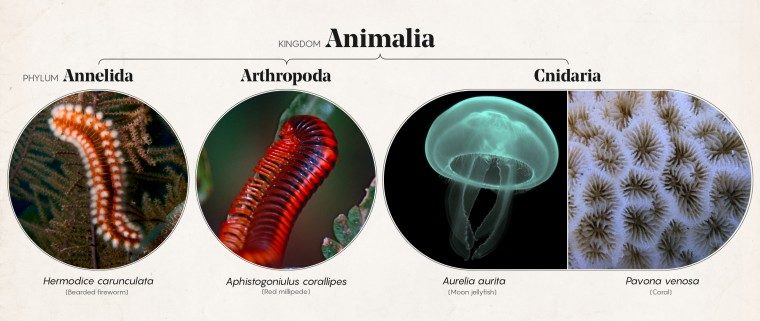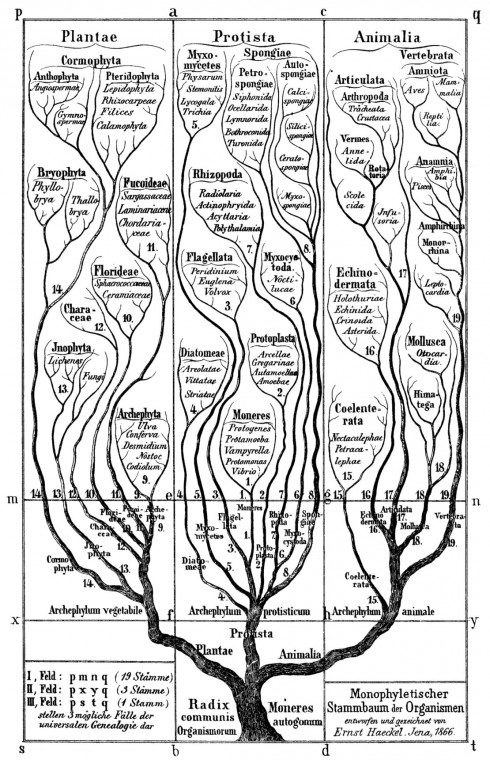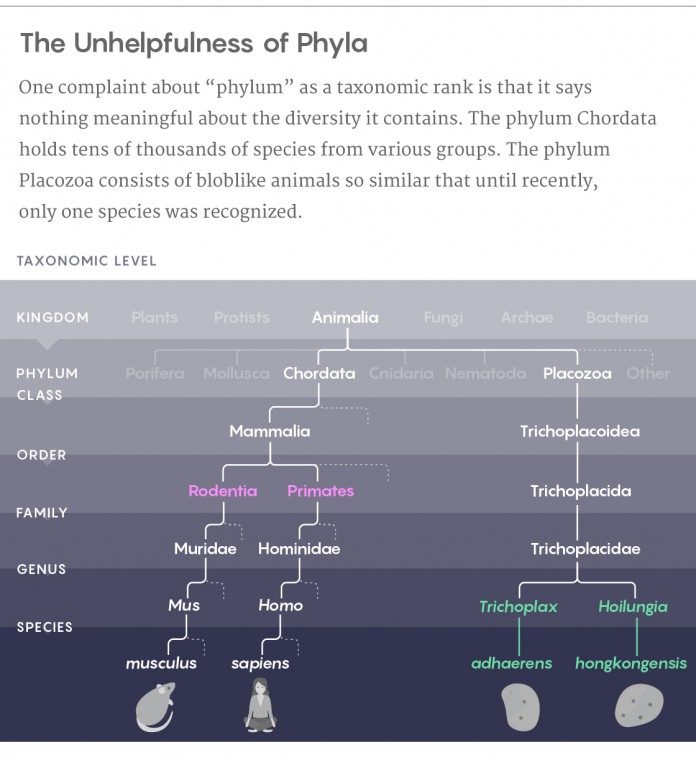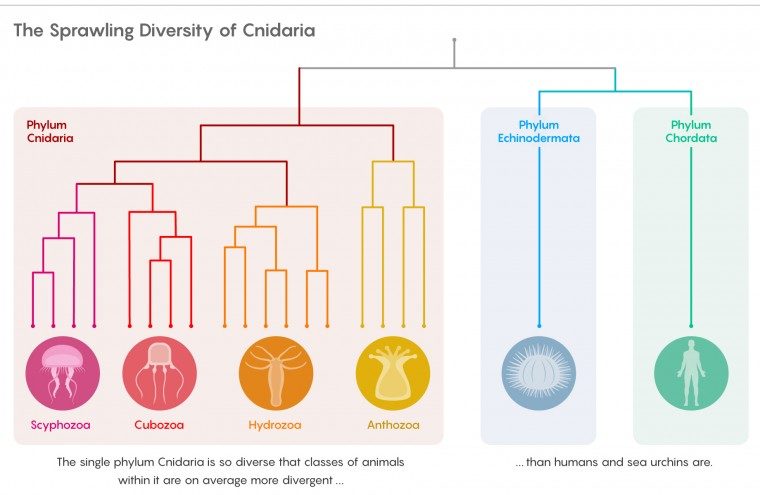
This ranked taxonomy - domain, kingdom, phylum, class, order, family, genus, species - is foundational to biology pedagogy. Every student learns it, often through a mnemonic like "Didn't Know Popeyes Chicken Offered Free Gizzard Strips" or "Dear King Phillip Came Over For Great Spaghetti."
But a growing number of researchers think it's time for taxonomy to move away from these ranks, or even abandon them altogether. "When a student has to learn it, it also suggests to the student that there's something special about these groups," said Andreas Hejnol, a comparative developmental biologist at the University of Bergen in Norway. Yet there isn't.
The problem that Hejnol sees with the whole system is that the ranks don't mean anything specific or uniform across all groups of life. Even though species is arguably the most important rank across multiple fields of biology, there are dozens of species concepts in use - and biologists working with different groups of organisms can't seem to agree on just one. You might think that the other end of the hierarchy would be more settled, but it wasn't so long ago that domains simply didn't exist - the three domains we use today (Archaea, Bacteria and Eucarya) were only proposed in 1990. At that time, the top rank was kingdom, and there were five of those; now there are at least six, though some say there should be as many as 32. Similar ambiguities plague all the taxonomic ranks in between - even those often considered to be major, distinct and unambiguous, like phyla.

These changes may occur over time. But in the interim, it's all too easy to forget that the ranks aren't consistently or broadly meaningful. And when people lean on these ranks to form evolutionary hypotheses or examine biodiversity, their science can be fundamentally flawed.
"I don't think we need to get rid of [taxonomic ranks]," said Ronald Jenner, a phylogeneticist at the Natural History Museum in London. "What we need to get rid of is the unwarranted connotations that higher-level taxa are comparable. Because they aren't. They are abstractions. They are information storage boxes. That's all they are." We can see this clearly by looking at phyla.
A Phylum by Any Other Name
Linnaeus was onto something when he proposed his hierarchical taxonomy, but he was too early to really grasp how lifeforms are related. Charles Darwin wouldn't publish On the Origin of Species for another hundred years. It shouldn't be surprising, then, that the taxonomic principles he established fail to capture the full reality of evolution.
"The traditional rules could just as easily be applied to rocks," de Queiroz remarked. Indeed, they were: Linnaeus proposed that a kingdom of minerals (Regnum Lapideum) should sit alongside the kingdoms of plants (Regnum Vegetabile) and animals (Regnum Animale). There's nothing intrinsic to a rank like family or phylum that makes it specific to living things. "It's just this arbitrary rank that we assign."

To Briggs and others, the delineations of phyla may be crude, but they are clear: They distinguish sets of organisms with "fundamentally different body plans." The definitions of body plans can draw on details of anatomy and tissue organization; they can also refer to one or more stages in an organism's life cycle or development. Individual characteristics may belong to multiple phyla, but the full set of characteristics is supposed to define each phylum uniquely. For example, among other defining traits, the anemones and jellyfish that make up the phylum Cnidaria are radially symmetrical, have an opening that serves as both mouth and anus, and capture prey with specialized stinging cells; the roundworms of the phylum Platyhelminthes have three distinct tissue layers as embryos, are bilaterally symmetrical, and lack a body cavity; the insects, spiders and crustaceans in the phylum Arthropoda have segmented exoskeletons and molt between developmental stages.
This idea that distinctive body plans could serve as an organizational scheme for life is actually older than the term phylum. The French zoologist Georges Cuvier sorted animal life into four "embranchments" based on comparative anatomy in 1817; similarly, the German scientist Karl Ernst von Baer identified four "animal types" based on embryology in 1828. The term phylum was coined by Ernst Haeckel in his Generelle Morphologie der Organismen, published in 1866. Haeckel specifically noted five phyla of animals - coelenterates, echinoderms, "articulates" (a group including annelids and arthropods), mollusks and vertebrates - but he used the term the way modern scientists might use the terms clade or monophyletic group to refer to a set of organisms that all descend from a common ancestor.

Ultimately, the decision to name a particular clade a phylum is "completely anthropogenic," Hejnol said. He also noted that the distinctions are biased to favor human perspectives on what looks different, because they tend to emphasize qualities obvious to our eyes over less visible ones, such as genomic characteristics.
But perhaps a bigger problem than the artificiality of the boundaries between phyla is that they also tell us little about the range in diversity within a phylum. Some, like the phylum Placozoa, have almost no morphological diversity: All placozoans look so much alike that researchers haven't yet decided whether there are only a handful of species or more than a hundred of them.
Other phyla contain creatures so divergent from their phylum's nominal body plan that they're almost impossible to recognize as members of that category. Tetraplatia, for example, is "a weird jelly that's more or less shaped like a worm," said Allen Collins, the director of the National Oceanic and Atmospheric Administration's National Systematics Lab. If it were part of an older lineage, Tetraplatia might be considered to belong in its own order, class or phylum rather than being lumped in as a bizarre hydrozoan beside the jellies, corals and anemones of the phylum Cnidaria.
Or take rhizocephalan barnacles. The adult females are internal parasites of crabs: They grow inside their hosts in a form that resembles a branching mass of roots. They look about as different from other arthropods as you could imagine. Nothing about the phylum label Arthropoda suggests that it contains such a weird departure from the rest - or that maybe it shouldn't.
Indeed, the irony is that no matter what strange new forms evolution may invent in eons to come, no new phyla can be created to house them - because future organisms must fall under the same phylum as their ancestors, and the only firm taxonomic rule defining a phylum is that it cannot be nested inside another phylum. "That shows you the artificiality of it," Jenner said, "because that parasitic barnacle may be as different from [its] arthropod ancestor as any other thing, but you cannot make it its own phylum."
This points to the paradox inherent in the phylum concept: In theory, phyla mark the morphological uniqueness of distinct body plans. But phyla can't really signify morphological uniqueness because the hierarchical system requires shoving all of life's divergent forms into ranks that treat them as equals, no matter how different they may really be. "Mother Nature can't be straitjacketed," Jenner said. "And if she makes a phylum-level difference - a 'hopeful monster' that looks nothing like its brethren - then yes, we should be able to say this is literally a phylum-level difference. But we can't."
Blowing Up the Cambrian Explosion
In reality, phyla are defined by more than body plans. They're often considered to be distinctive groups of organisms that arose within a particular stretch of 5 to 20 million years during the early Cambrian Period, which started more than 500 million years ago. The sudden burst of diversity during this time is often referred to as the "Cambrian explosion," and as James Valentine, professor emeritus of biology at the University of California, Berkeley, once explained, it's thought to have occurred because the lack of animal biodiversity up to that point was unique in the history of life. Some say that abrupt climatological or geological shifts were important, too - but whatever the exact trigger, the way that evolution altered species back then was seemingly different from the way it alters them now.
But more recent data have countered this idea that there was something special about the diversification of life a half-billion years ago. The discovery of new fossils that sit on the "stems" of currently recognized phyla show that the so-called body plans actually arose stepwise over time. Their apparent morphological distance from one another could therefore be purely an artifact of fossilization and extinction, without being representative of unique biological processes. Some biologists, like the paleogenomics researcher David A. Gold at the University of California, Davis, have proposed that what happened in the early Cambrian was less an "explosion" than the ignition of a "long fuse" of biological innovation. Others argue for a series of pulses of diversification.
One thing is clear: The phyla didn't all pop into existence at the same time. Cnidarians, for example, had already split into the lineages we recognize as classes before echinoderms came onto the scene. As a 2019 paper in Nature Ecology and Evolution pointed out, there is more divergence between those cnidarian classes - which include the Scyphozoa (jellyfish), the Cubozoa (box jellies), the Anthozoa (sea anemones, corals, sea pens), and the highly diverse Hydrozoa - than between humans and sea urchins.
Some biologists have argued that the definitions of phyla and other taxonomic ranks should be based more strictly on when these groups evolved. Of course, considerable changes would need to be made to the currently recognized phyla: Either later-evolving groups would have to be lumped together, or lower ranks in older clades like the Cnidaria would need to be elevated to the rank of phylum.
Even if phyla were defined on the basis of evolutionary timing, deciding which point in the evolutionary process to use would still be arbitrary and anthropogenic. "If you want to be consistent," Jenner said, each rank would have to be tied to an evolutionary split and would contain only sister groups - so there would be two phyla, and then two subphyla from each of them, and so on. But that's impractical too, according to Jenner, because it would mean that everything that isn't a sponge belongs in one phylum. "Nobody would say that's a good idea."
Despite the varying degrees of morphological divergence and the range of divergence times among phyla, many evolutionary biologists remain convinced that there is something unique about them. This idea is pervasive in evolutionary developmental biology, for example, with many groups seeking to find an objective definition for phyla. In a 2016 Nature paper, for example, a group of researchers claimed to have found that long-sought defining feature. After examining developmental transcriptomes from 10 animals belonging to putatively different phyla, they concluded that unique signaling pathways in the middle of development can be used to objectively define phyla.
But to Hejnol, searching for the unique characteristics that define Linnaean ranks is "wrong evolutionary thinking." Hejnol and his colleagues not only found flaws in the statistical analyses used in that study, but also discovered a more fundamental error: the conflation of current patterns with the processes that led to them. Notable differences between individual species within phyla are to be expected because each lineage developed independently over hundreds of millions of years. That tells us almost nothing, though, about how the lineages originally split.
And if we were to base ranks on some molecular metric like genetic distance (the number of mutational differences between diverging populations), that would probably introduce even more problems, de Queiroz said, "because there's lots of inequalities and rates of evolution even at the genetic level."
In the end, there simply seem to be no objective, consistent criteria by which to define a phylum - or any other rank, for that matter. "So far, all explanations of what a phylum is have badly failed," Hejnol said. "This is not a scientific entity which we can use, or should continue to use, when we communicate with each other."
Meaningless, but Not Useless
The ranked system isn't entirely subjective, of course. The hierarchical nature does provide some meaningful information - so long as you stay within a group. "A class of snails cannot be meaningfully compared with a class of fish. It's apples and oranges completely," Jenner said. "It only makes sense within the context of that one branch on the tree."
Unfortunately, scientists make apples-to-oranges comparisons based on Linnaean ranks all the time. For example, they may talk about rank-level characteristics, such as divergence at the genus level, that vary greatly between groups. Claims like "arthropods have the most species of any phylum" don't really tell us anything about evolution if the ranks aren't objectively defined. When ecologists describe the variety of species in a given region by using families and orders as surrogates, this not only conflates rank with diversity but "prevents us from discovering the true biodiversity of animals and other organisms," Hejnol said.
Taxonomic labels are still merely labels - names devoid of units. "The labels without the units make no sense," Jenner said. "Even though it's heartwarmingly, beautifully attractive to keep thinking in terms of this hierarchy and these classes, without extra information it means nothing. It's old-fashioned."
Briggs, like many scientists, acknowledges that the Linnaean ranked system has flaws and can lead to errors. But to do away with it, biologists would need a replacement. "I think it'll continue to have a place of sorts for some considerable time, because it is the lingua franca of the biologist in the field," he said.
"I'm not as extreme as some who think we should just get rid of them completely," de Queiroz said. But he does see the traditional ranked system as a "weird, outmoded way of thinking" that emphasizes placement in the hierarchy over biological meaning.
He and his colleagues have proposed an alternative system, the PhyloCode, to avoid these problems. Currently, taxonomic names are associated with particular ranks in the Linnaean hierarchy. Consider a large group of beetles that has been categorized as its own family: If further research shows that it should really be considered a branch of another family, then either the original beetle group must be "demoted" and renamed, or the second family needs to be "promoted" to a higher taxonomic designation and all the beetles within it need to be regrouped into their own new families. More knowledge disrupted the taxonomy. The PhyloCode instead ties a name for a clade explicitly to a phylogenetic description of the evolutionary connections among the beetle species (for example, "the smallest clade that can include species A, B and C"). That name would be more stable and enduringly meaningful because it could handle any new evolutionary connections that come to light.
The attachment to the Linnaean system seems to be largely driven by inertia. Throwing out ranks and defining life by some objective measure would be a big change, de Queiroz says, and no one seems ready to do that. "Instead, they just keep using them in ways that don't really have any meaning."
Collins also acknowledges a lack of urgency. Scientists can usually sidestep the problems with taxonomic rankings by separating discussions about how organisms evolved from arguments about how to name or classify them. "When you're doing evolution, you're doing evolution. And when you're doing systematics and taxonomy, that's a different thing," he said. That separation may be awkward, but "it's clunky because life is clunky."
But de Queiroz is hopeful that times are changing. Although he and his colleagues first proposed a naming system based on phylogeny almost two decades ago, they've spent much of the time since then codifying those rules as the PhyloCode and getting researchers like Collins to apply them to the naming of clades for the particular animals they study. That body of work is finally being readied for publication, according to de Queiroz, and it will likely be published within the next few years.





Best we don't forget the foundation.